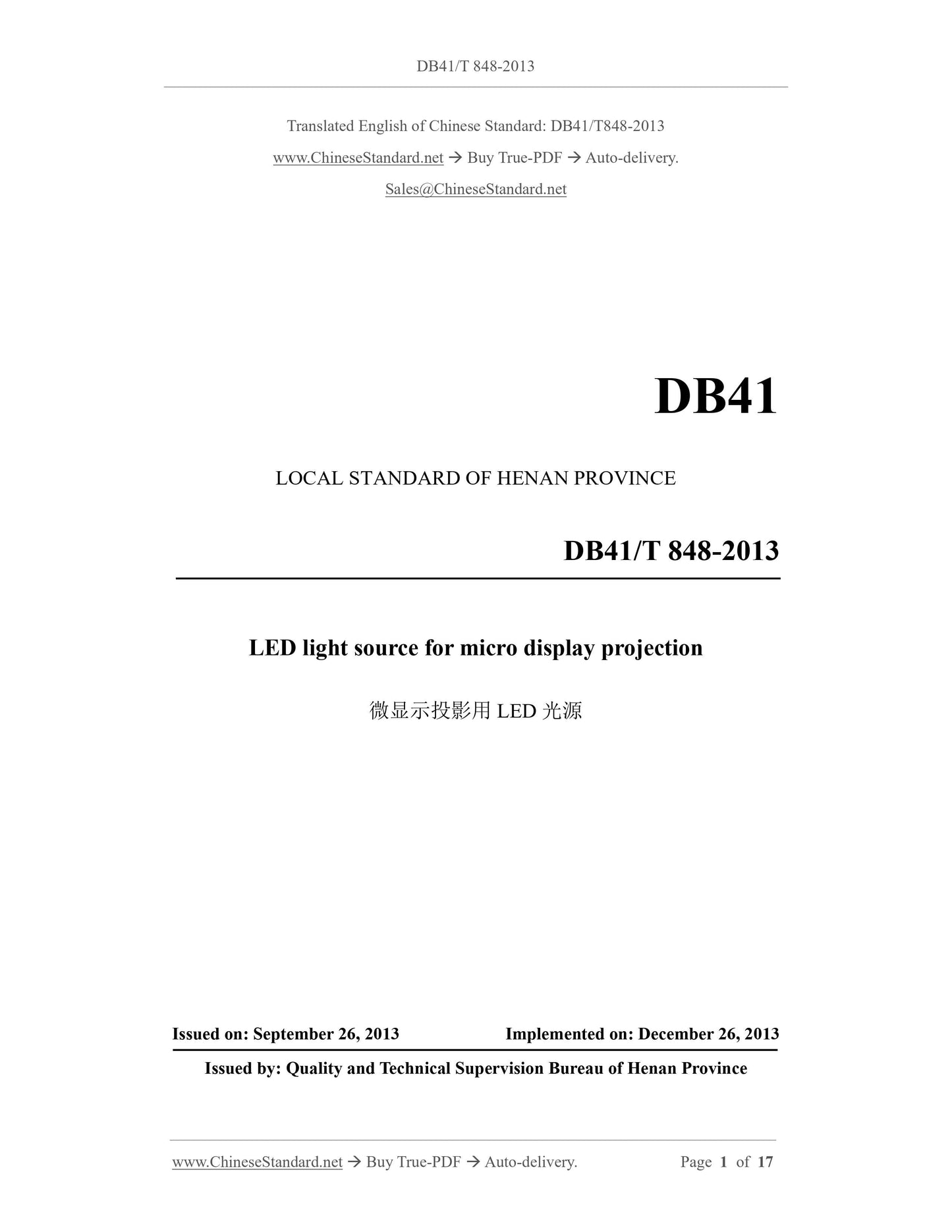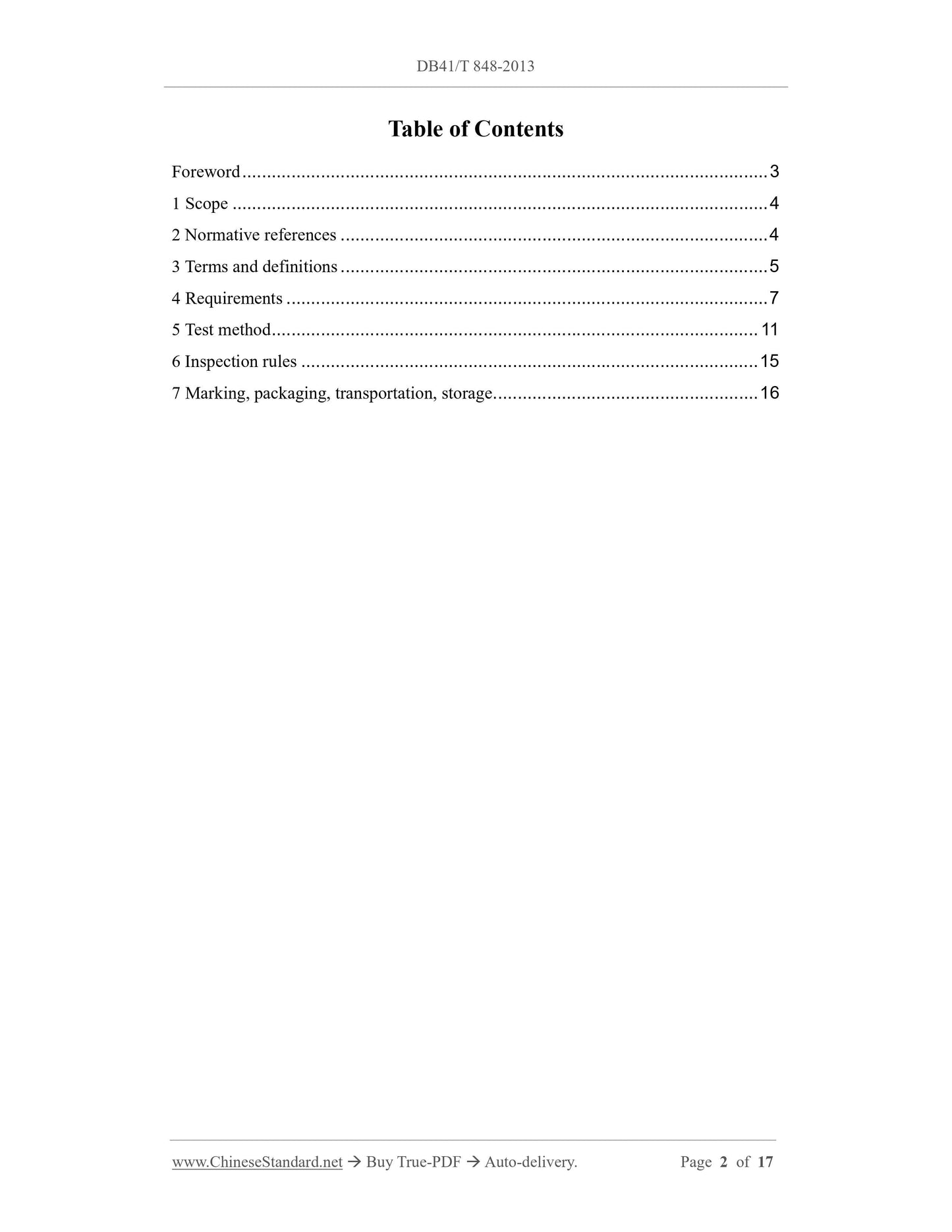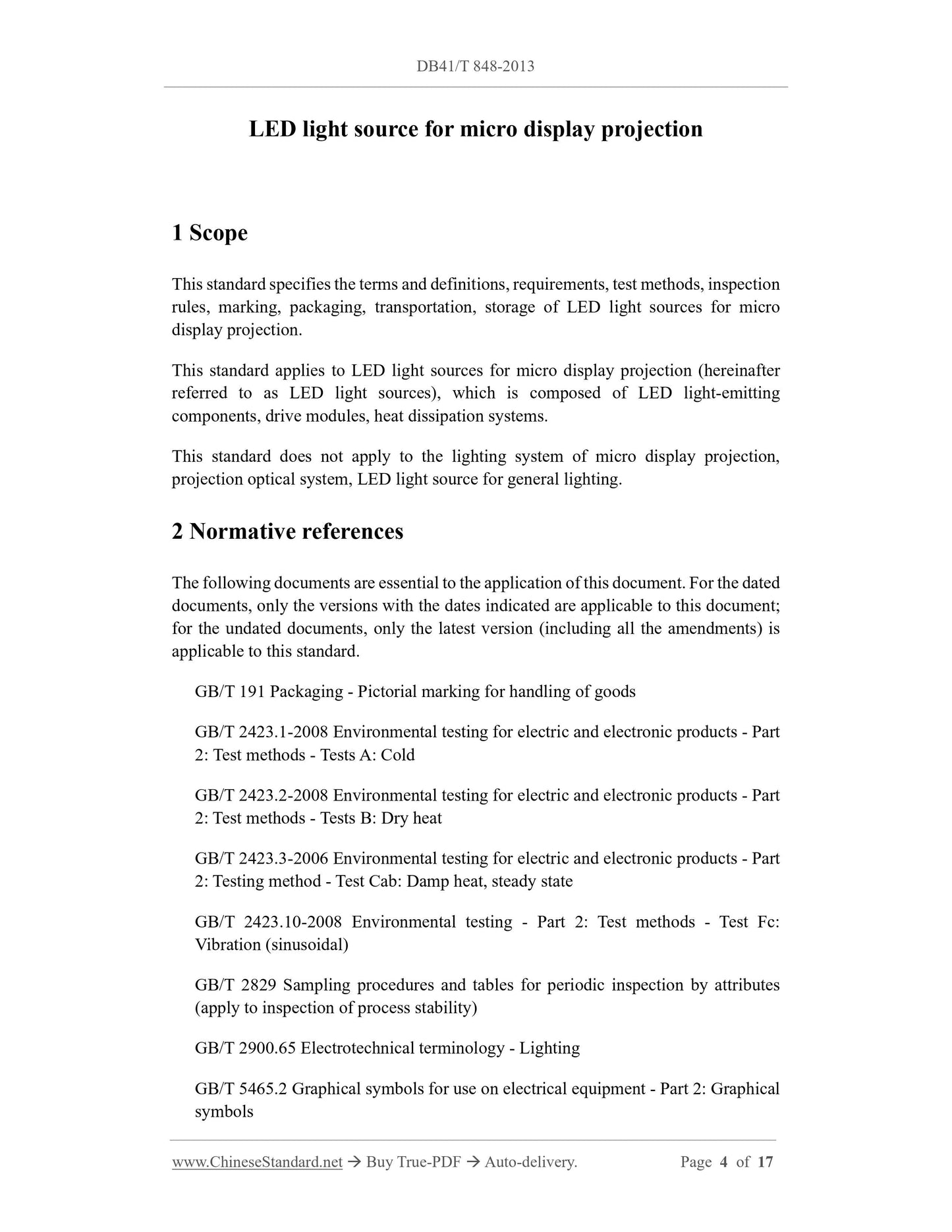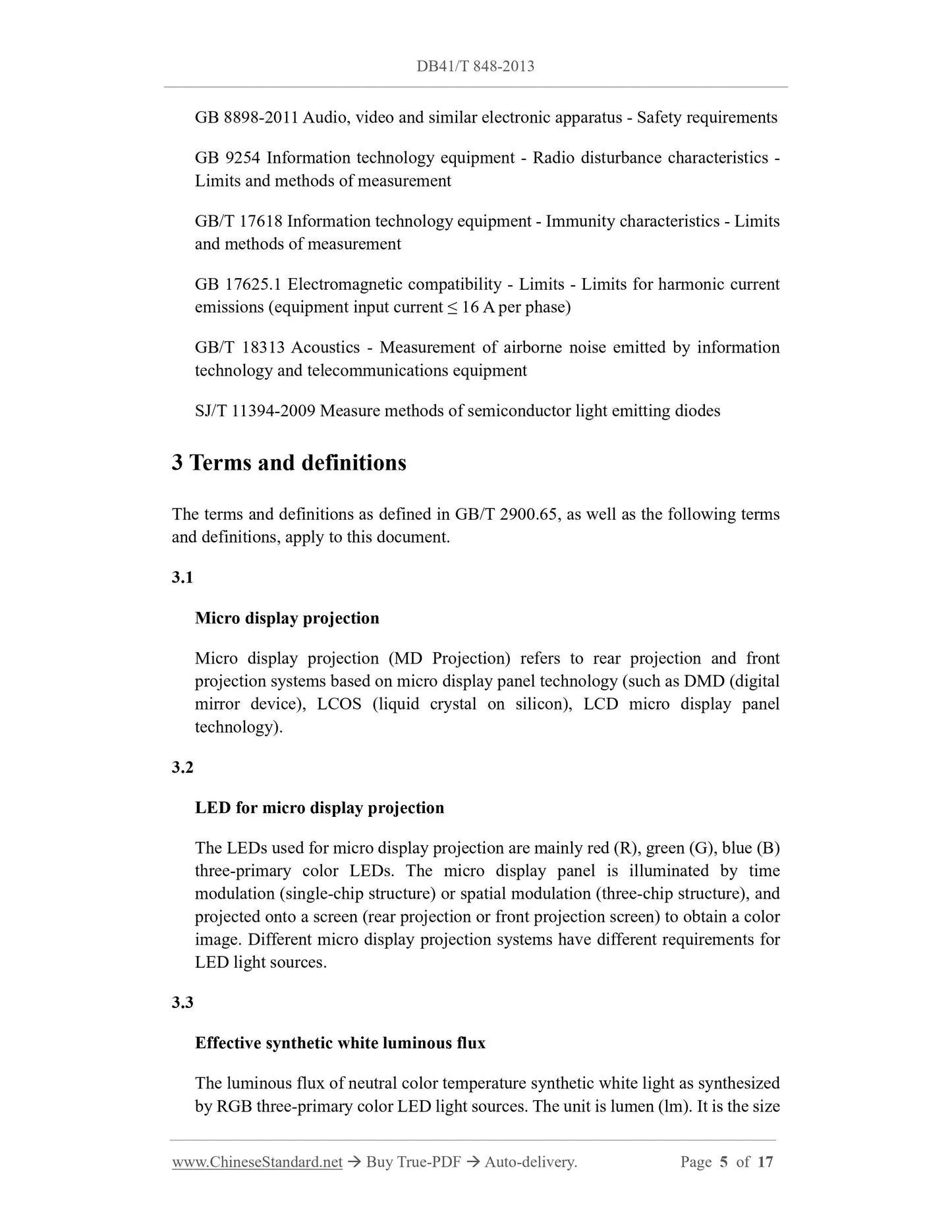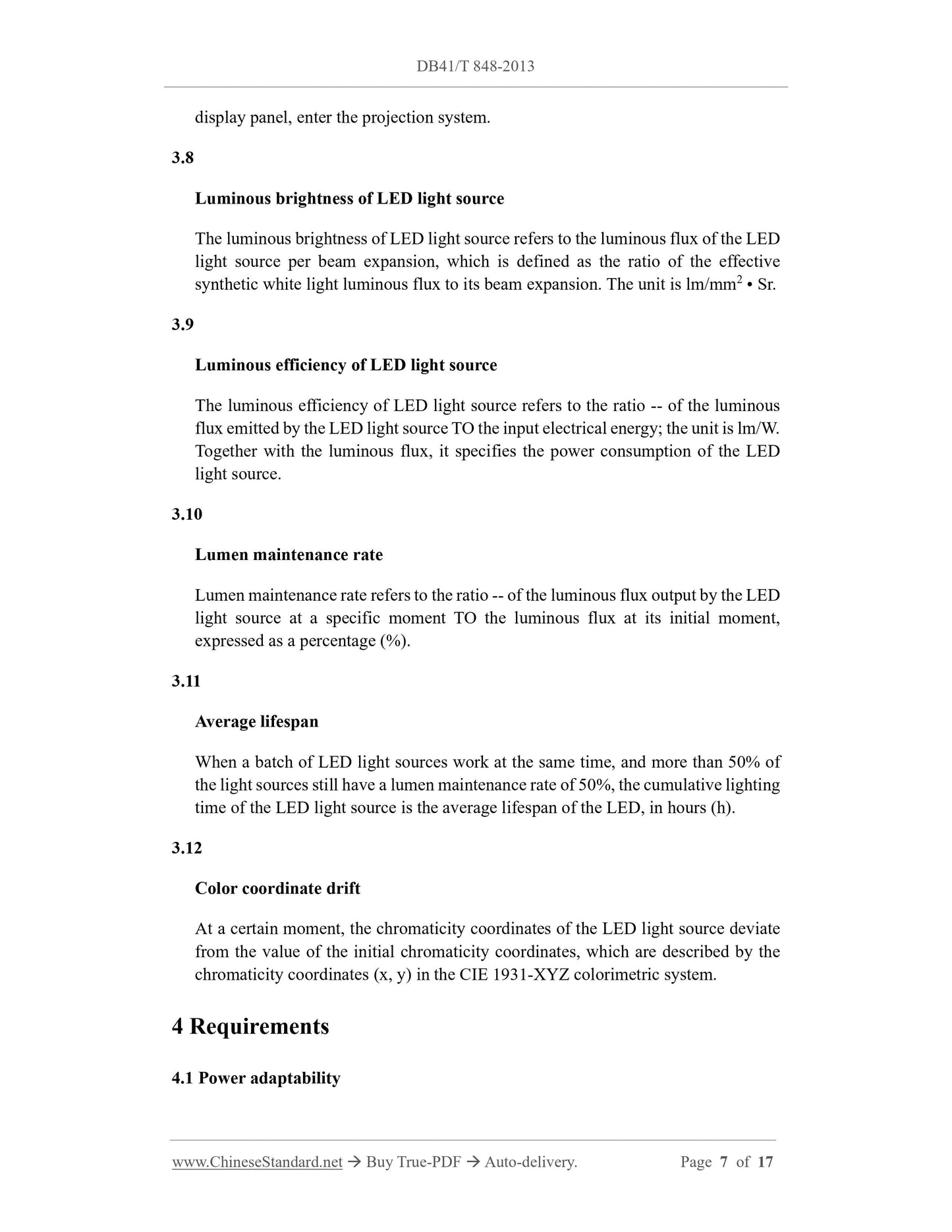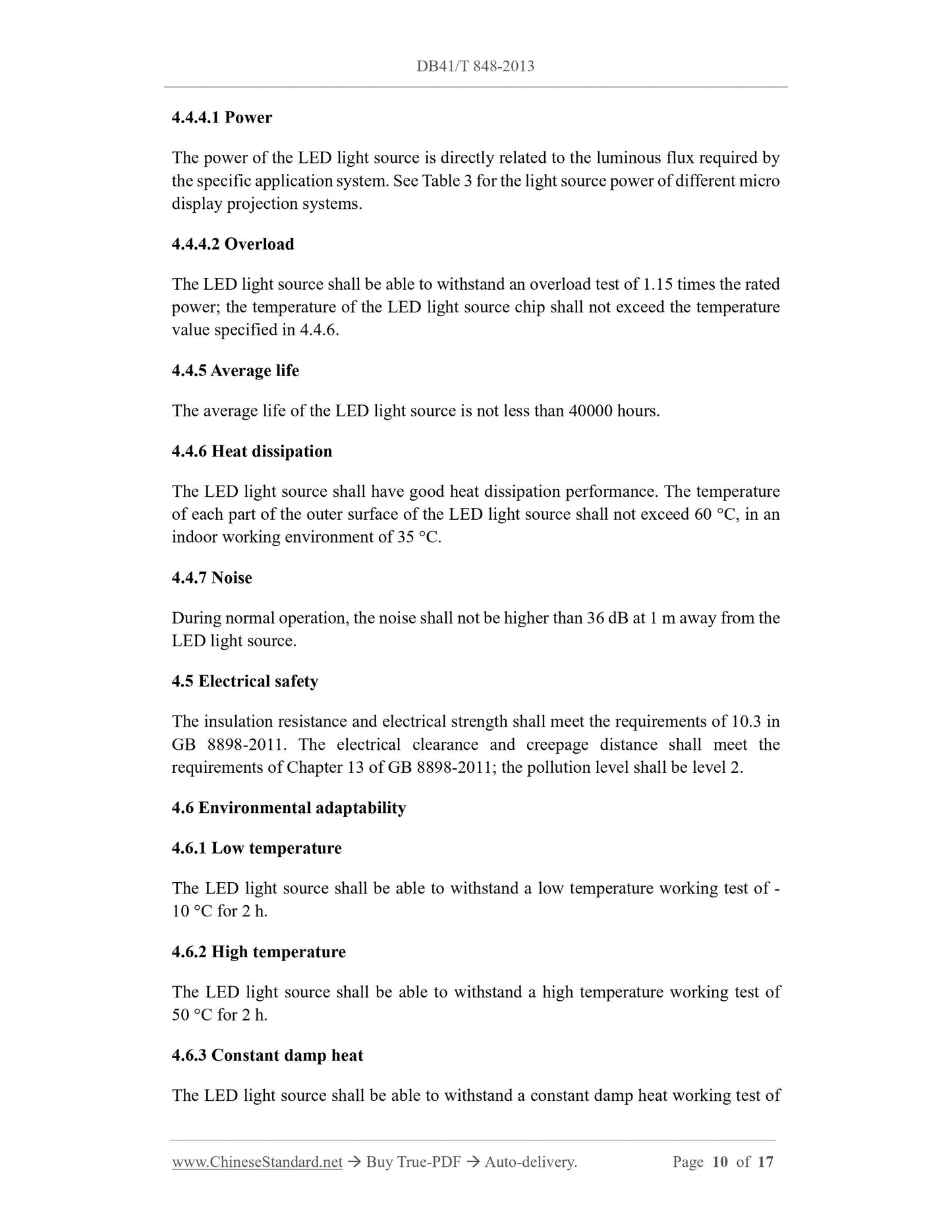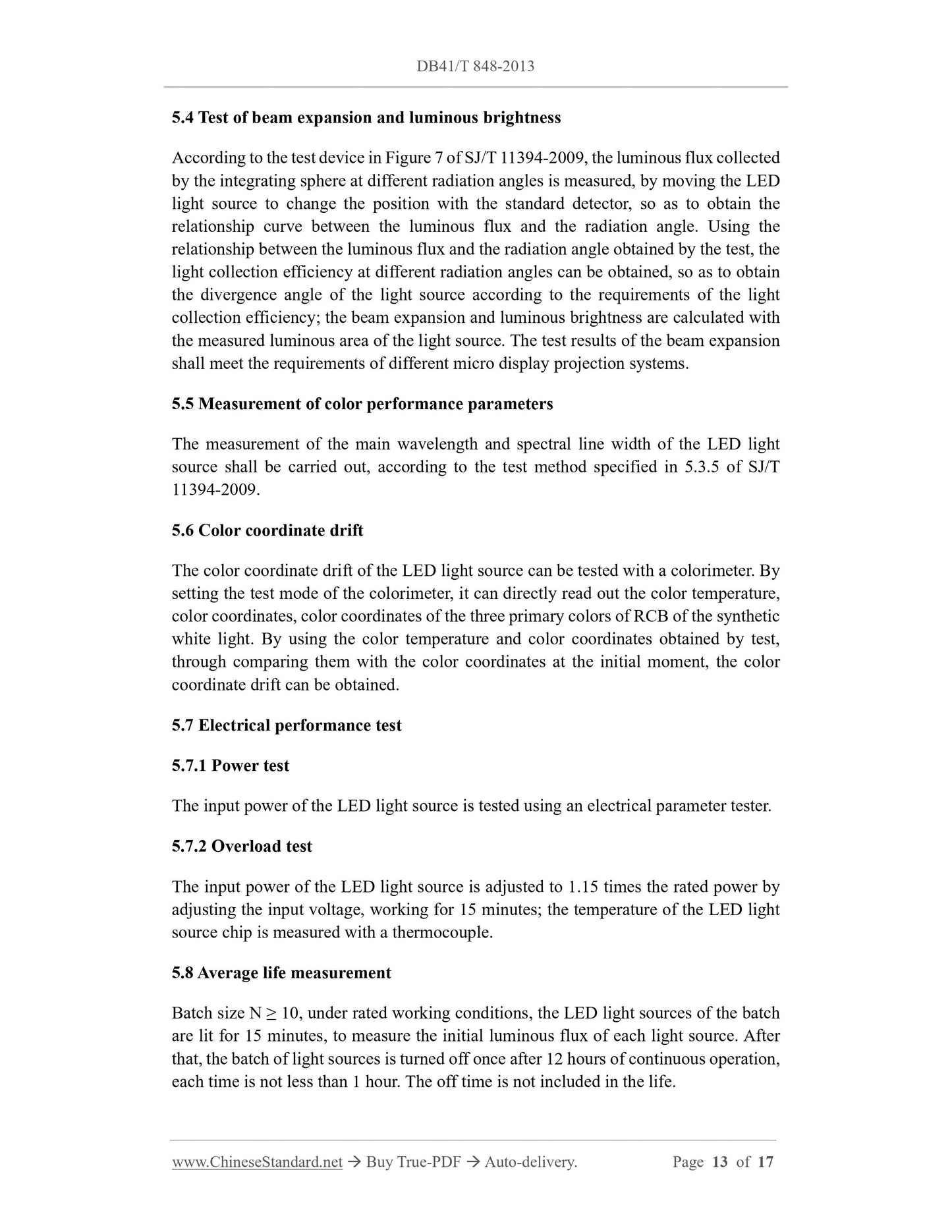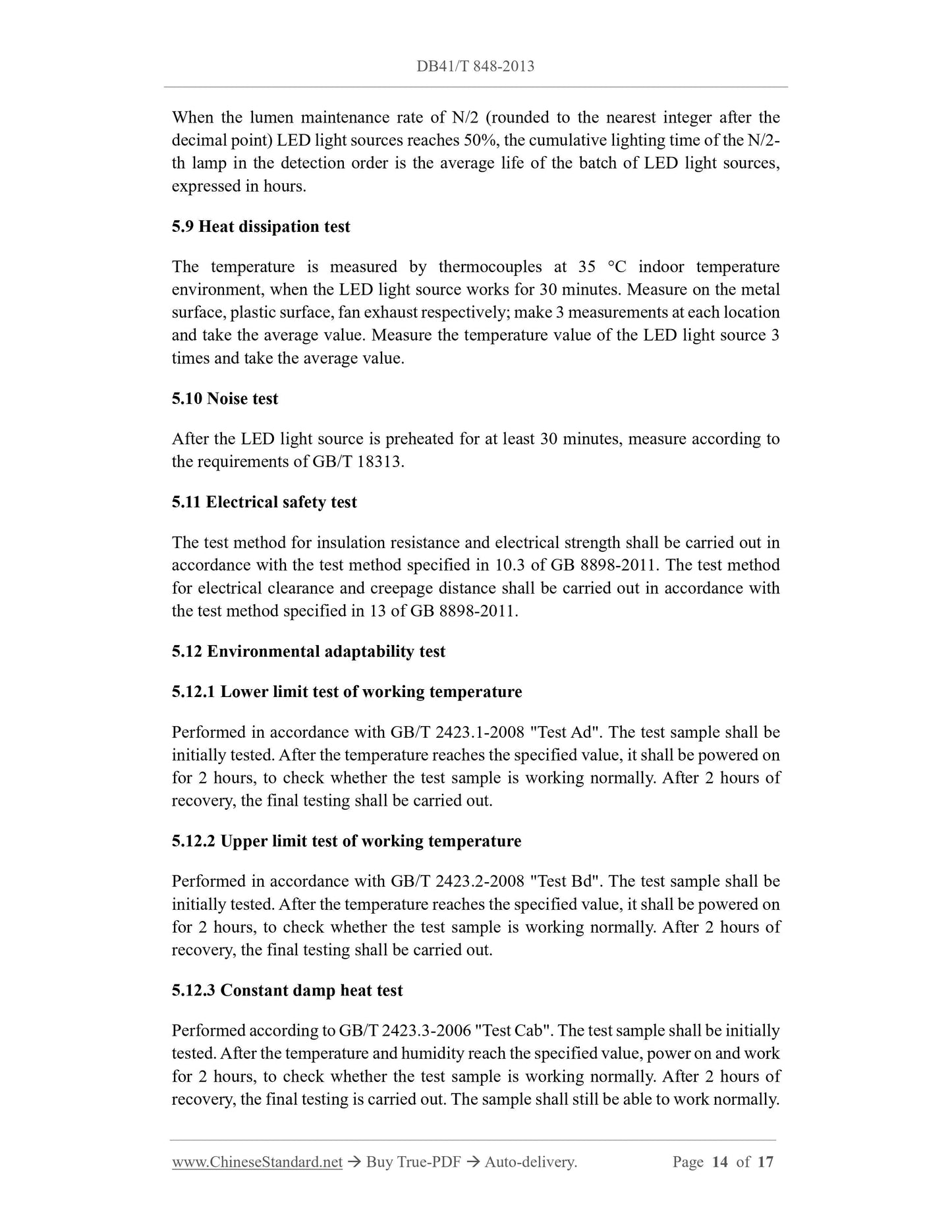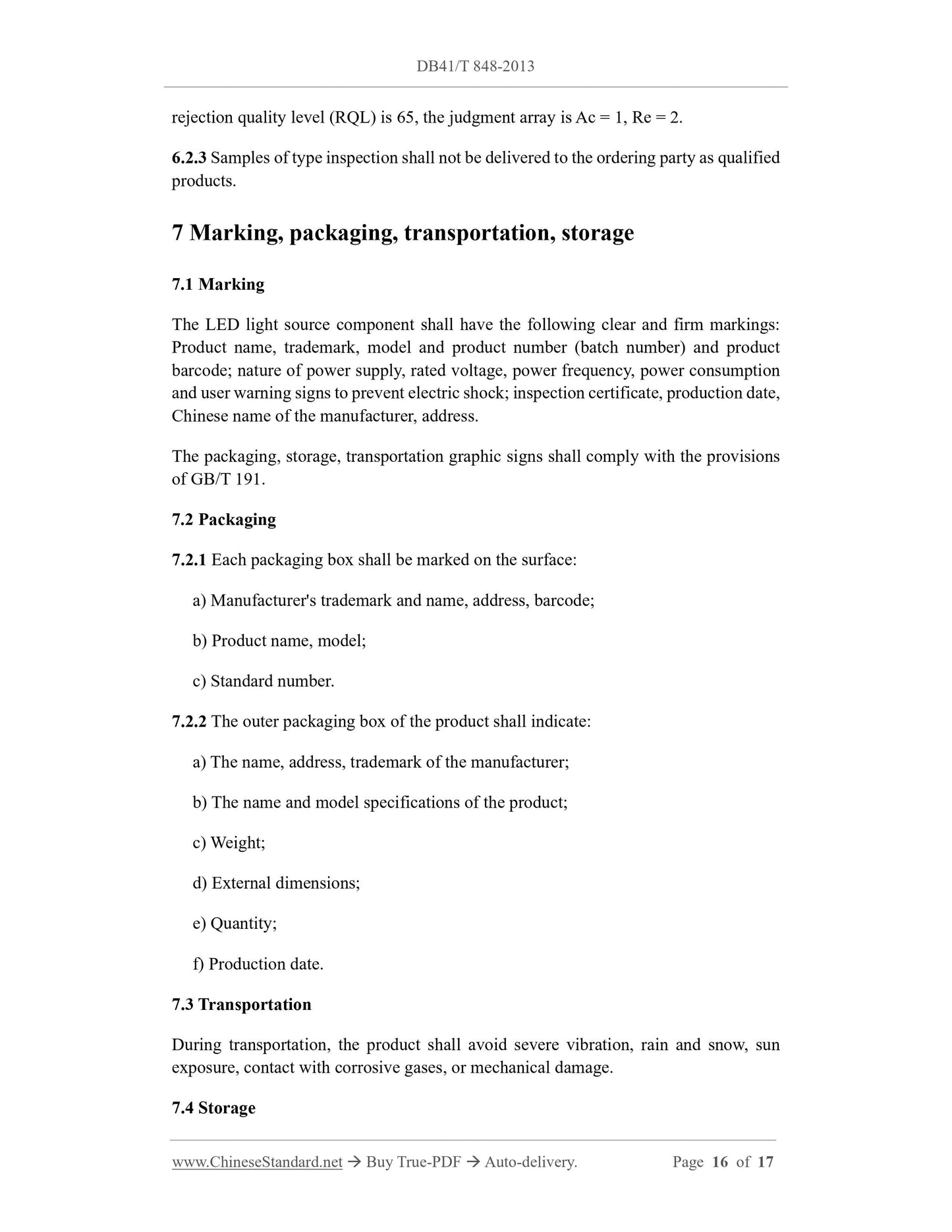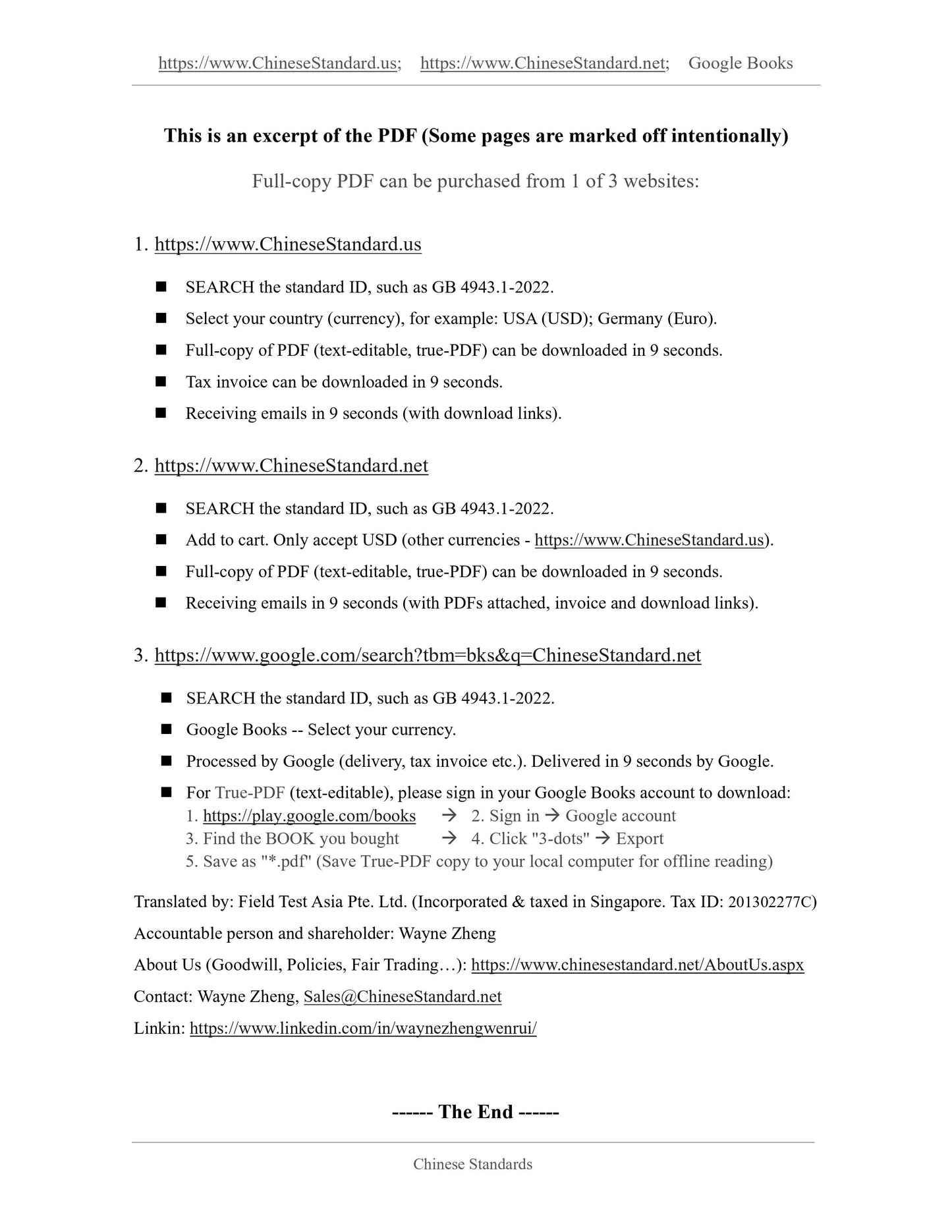1
/
su
10
PayPal, credit cards. Download editable-PDF and invoice in 1 second!
DB41/T 848-2013 English PDF (DB41T848-2013)
DB41/T 848-2013 English PDF (DB41T848-2013)
Prezzo di listino
$360.00 USD
Prezzo di listino
Prezzo scontato
$360.00 USD
Prezzo unitario
/
per
Spese di spedizione calcolate al check-out.
Impossibile caricare la disponibilità di ritiro
Delivery: 3 seconds. Download true-PDF + Invoice.
Get QUOTATION in 1-minute: Click DB41/T 848-2013
Historical versions: DB41/T 848-2013
Preview True-PDF (Reload/Scroll if blank)
DB41/T 848-2013: LED light source for micro display projection
DB41/T 848-2013
DB41
LOCAL STANDARD OF HENAN PROVINCE
LED light source for micro display projection
ISSUED ON. SEPTEMBER 26, 2013
IMPLEMENTED ON. DECEMBER 26, 2013
Issued by. Quality and Technical Supervision Bureau of Henan Province
Table of Contents
Foreword... 3
1 Scope... 4
2 Normative references... 4
3 Terms and definitions... 5
4 Requirements... 7
5 Test method... 11
6 Inspection rules... 15
7 Marking, packaging, transportation, storage... 16
LED light source for micro display projection
1 Scope
This standard specifies the terms and definitions, requirements, test methods, inspection
rules, marking, packaging, transportation, storage of LED light sources for micro
display projection.
This standard applies to LED light sources for micro display projection (hereinafter
referred to as LED light sources), which is composed of LED light-emitting
components, drive modules, heat dissipation systems.
This standard does not apply to the lighting system of micro display projection,
projection optical system, LED light source for general lighting.
2 Normative references
The following documents are essential to the application of this document. For the dated
documents, only the versions with the dates indicated are applicable to this document;
for the undated documents, only the latest version (including all the amendments) is
applicable to this standard.
GB/T 191 Packaging - Pictorial marking for handling of goods
GB/T 2423.1-2008 Environmental testing for electric and electronic products - Part
2.Test methods - Tests A. Cold
GB/T 2423.2-2008 Environmental testing for electric and electronic products - Part
2.Test methods - Tests B. Dry heat
GB/T 2423.3-2006 Environmental testing for electric and electronic products - Part
2.Testing method - Test Cab. Damp heat, steady state
GB/T 2423.10-2008 Environmental testing - Part 2.Test methods - Test Fc.
Vibration (sinusoidal)
GB/T 2829 Sampling procedures and tables for periodic inspection by attributes
(apply to inspection of process stability)
GB/T 2900.65 Electrotechnical terminology - Lighting
GB/T 5465.2 Graphical symbols for use on electrical equipment - Part 2.Graphical
symbols
GB 8898-2011 Audio, video and similar electronic apparatus - Safety requirements
GB 9254 Information technology equipment - Radio disturbance characteristics -
Limits and methods of measurement
GB/T 17618 Information technology equipment - Immunity characteristics - Limits
and methods of measurement
GB 17625.1 Electromagnetic compatibility - Limits - Limits for harmonic current
emissions (equipment input current ≤ 16 A per phase)
GB/T 18313 Acoustics - Measurement of airborne noise emitted by information
technology and telecommunications equipment
SJ/T 11394-2009 Measure methods of semiconductor light emitting diodes
3 Terms and definitions
The terms and definitions as defined in GB/T 2900.65, as well as the following terms
and definitions, apply to this document.
3.1
Micro display projection
Micro display projection (MD Projection) refers to rear projection and front
projection systems based on micro display panel technology (such as DMD (digital
mirror device), LCOS (liquid crystal on silicon), LCD micro display panel
technology).
3.2
LED for micro display projection
The LEDs used for micro display projection are mainly red (R), green (G), blue (B)
three-primary color LEDs. The micro display panel is illuminated by time
modulation (single-chip structure) or spatial modulation (three-chip structure), and
projected onto a screen (rear projection or front projection screen) to obtain a color
image. Different micro display projection systems have different requirements for
LED light sources.
3.3
Effective synthetic white luminous flux
The luminous flux of neutral color temperature synthetic white light as synthesized
by RGB three-primary color LED light sources. The unit is lumen (lm). It is the size
display panel, enter the projection system.
3.8
Luminous brightness of LED light source
The luminous brightness of LED light source refers to the luminous flux of the LED
light source per beam expansion, which is defined as the ratio of the effective
synthetic white light luminous flux to its beam expansion. The unit is lm/mm2 • Sr.
3.9
Luminous efficiency of LED light source
The luminous efficiency of LED light source refers to the ratio -- of the luminous
flux emitted by the LED light source TO the input electrical energy; the unit is lm/W.
Together with the luminous flux, it specifies the power consumption of the LED
light source.
3.10
Lumen maintenance rate
Lumen maintenance rate refers to the ratio -- of the luminous flux output by the LED
light source at a specific moment TO the luminous flux at its initial moment,
expressed as a percentage (%).
3.11
Average lifespan
When a batch of LED light sources work at the same time, and more than 50% of
the light sources still have a lumen maintenance rate of 50%, the cumulative lighting
time of the LED light source is the average lifespan of the LED, in hours (h).
3.12
Color coordinate drift
At a certain moment, the chromaticity coordinates of the LED light source deviate
from the value of the initial chromaticity coordinates, which are described by the
chromaticity coordinates (x, y) in the CIE 1931-XYZ colorimetric system.
4 Requirements
4.1 Power adaptability
4.4.4.1 Power
The power of the LED light source is directly related to the luminous flux required by
the specific application system. See Table 3 for the light source power of different micro
display projection systems.
4.4.4.2 Overload
The LED light source shall be able to withstand an overload test of 1.15 times the rated
power; the temperature of the LED light source chip shall not exceed the temperature
value specified in 4.4.6.
4.4.5 Average life
The average life of the LED light source is not less than 40000 hours.
4.4.6 Heat dissipation
The LED light source shall have good heat dissipation performance. The temperature
of each part of the outer surface of the LED light source shall not exceed 60 °C, in an
indoor working environment of 35 °C.
4.4.7 Noise
During normal operation, the noise shall not be higher than 36 dB at 1 m away from the
LED light source.
4.5 Electrical safety
The insulation resistance and electrical strength shall meet the requirements of 10.3 in
GB 8898-2011.The electrical clearance and creepage distance shall meet the
requirements of Chapter 13 of GB 8898-2011; the pollution level shall be level 2.
4.6 Environmental adaptability
4.6.1 Low temperature
The LED light source shall be able to withstand a low temperature working test of -
10 °C for 2 h.
4.6.2 High temperature
The LED light source shall be able to withstand a high temperature working test of
50 °C for 2 h.
4.6.3 Constant damp heat
The LED light source shall be able to withstand a constant damp heat working test of
5.4 Test of beam expansion and luminous brightness
According to the test device in Figure 7 of SJ/T 11394-2009, the luminous flux collected
by the integrating sphere at different radiation angles is measured, by moving the LED
light source to change the position with the standard detector, so as to obtain the
relatio...
Get QUOTATION in 1-minute: Click DB41/T 848-2013
Historical versions: DB41/T 848-2013
Preview True-PDF (Reload/Scroll if blank)
DB41/T 848-2013: LED light source for micro display projection
DB41/T 848-2013
DB41
LOCAL STANDARD OF HENAN PROVINCE
LED light source for micro display projection
ISSUED ON. SEPTEMBER 26, 2013
IMPLEMENTED ON. DECEMBER 26, 2013
Issued by. Quality and Technical Supervision Bureau of Henan Province
Table of Contents
Foreword... 3
1 Scope... 4
2 Normative references... 4
3 Terms and definitions... 5
4 Requirements... 7
5 Test method... 11
6 Inspection rules... 15
7 Marking, packaging, transportation, storage... 16
LED light source for micro display projection
1 Scope
This standard specifies the terms and definitions, requirements, test methods, inspection
rules, marking, packaging, transportation, storage of LED light sources for micro
display projection.
This standard applies to LED light sources for micro display projection (hereinafter
referred to as LED light sources), which is composed of LED light-emitting
components, drive modules, heat dissipation systems.
This standard does not apply to the lighting system of micro display projection,
projection optical system, LED light source for general lighting.
2 Normative references
The following documents are essential to the application of this document. For the dated
documents, only the versions with the dates indicated are applicable to this document;
for the undated documents, only the latest version (including all the amendments) is
applicable to this standard.
GB/T 191 Packaging - Pictorial marking for handling of goods
GB/T 2423.1-2008 Environmental testing for electric and electronic products - Part
2.Test methods - Tests A. Cold
GB/T 2423.2-2008 Environmental testing for electric and electronic products - Part
2.Test methods - Tests B. Dry heat
GB/T 2423.3-2006 Environmental testing for electric and electronic products - Part
2.Testing method - Test Cab. Damp heat, steady state
GB/T 2423.10-2008 Environmental testing - Part 2.Test methods - Test Fc.
Vibration (sinusoidal)
GB/T 2829 Sampling procedures and tables for periodic inspection by attributes
(apply to inspection of process stability)
GB/T 2900.65 Electrotechnical terminology - Lighting
GB/T 5465.2 Graphical symbols for use on electrical equipment - Part 2.Graphical
symbols
GB 8898-2011 Audio, video and similar electronic apparatus - Safety requirements
GB 9254 Information technology equipment - Radio disturbance characteristics -
Limits and methods of measurement
GB/T 17618 Information technology equipment - Immunity characteristics - Limits
and methods of measurement
GB 17625.1 Electromagnetic compatibility - Limits - Limits for harmonic current
emissions (equipment input current ≤ 16 A per phase)
GB/T 18313 Acoustics - Measurement of airborne noise emitted by information
technology and telecommunications equipment
SJ/T 11394-2009 Measure methods of semiconductor light emitting diodes
3 Terms and definitions
The terms and definitions as defined in GB/T 2900.65, as well as the following terms
and definitions, apply to this document.
3.1
Micro display projection
Micro display projection (MD Projection) refers to rear projection and front
projection systems based on micro display panel technology (such as DMD (digital
mirror device), LCOS (liquid crystal on silicon), LCD micro display panel
technology).
3.2
LED for micro display projection
The LEDs used for micro display projection are mainly red (R), green (G), blue (B)
three-primary color LEDs. The micro display panel is illuminated by time
modulation (single-chip structure) or spatial modulation (three-chip structure), and
projected onto a screen (rear projection or front projection screen) to obtain a color
image. Different micro display projection systems have different requirements for
LED light sources.
3.3
Effective synthetic white luminous flux
The luminous flux of neutral color temperature synthetic white light as synthesized
by RGB three-primary color LED light sources. The unit is lumen (lm). It is the size
display panel, enter the projection system.
3.8
Luminous brightness of LED light source
The luminous brightness of LED light source refers to the luminous flux of the LED
light source per beam expansion, which is defined as the ratio of the effective
synthetic white light luminous flux to its beam expansion. The unit is lm/mm2 • Sr.
3.9
Luminous efficiency of LED light source
The luminous efficiency of LED light source refers to the ratio -- of the luminous
flux emitted by the LED light source TO the input electrical energy; the unit is lm/W.
Together with the luminous flux, it specifies the power consumption of the LED
light source.
3.10
Lumen maintenance rate
Lumen maintenance rate refers to the ratio -- of the luminous flux output by the LED
light source at a specific moment TO the luminous flux at its initial moment,
expressed as a percentage (%).
3.11
Average lifespan
When a batch of LED light sources work at the same time, and more than 50% of
the light sources still have a lumen maintenance rate of 50%, the cumulative lighting
time of the LED light source is the average lifespan of the LED, in hours (h).
3.12
Color coordinate drift
At a certain moment, the chromaticity coordinates of the LED light source deviate
from the value of the initial chromaticity coordinates, which are described by the
chromaticity coordinates (x, y) in the CIE 1931-XYZ colorimetric system.
4 Requirements
4.1 Power adaptability
4.4.4.1 Power
The power of the LED light source is directly related to the luminous flux required by
the specific application system. See Table 3 for the light source power of different micro
display projection systems.
4.4.4.2 Overload
The LED light source shall be able to withstand an overload test of 1.15 times the rated
power; the temperature of the LED light source chip shall not exceed the temperature
value specified in 4.4.6.
4.4.5 Average life
The average life of the LED light source is not less than 40000 hours.
4.4.6 Heat dissipation
The LED light source shall have good heat dissipation performance. The temperature
of each part of the outer surface of the LED light source shall not exceed 60 °C, in an
indoor working environment of 35 °C.
4.4.7 Noise
During normal operation, the noise shall not be higher than 36 dB at 1 m away from the
LED light source.
4.5 Electrical safety
The insulation resistance and electrical strength shall meet the requirements of 10.3 in
GB 8898-2011.The electrical clearance and creepage distance shall meet the
requirements of Chapter 13 of GB 8898-2011; the pollution level shall be level 2.
4.6 Environmental adaptability
4.6.1 Low temperature
The LED light source shall be able to withstand a low temperature working test of -
10 °C for 2 h.
4.6.2 High temperature
The LED light source shall be able to withstand a high temperature working test of
50 °C for 2 h.
4.6.3 Constant damp heat
The LED light source shall be able to withstand a constant damp heat working test of
5.4 Test of beam expansion and luminous brightness
According to the test device in Figure 7 of SJ/T 11394-2009, the luminous flux collected
by the integrating sphere at different radiation angles is measured, by moving the LED
light source to change the position with the standard detector, so as to obtain the
relatio...
Share
